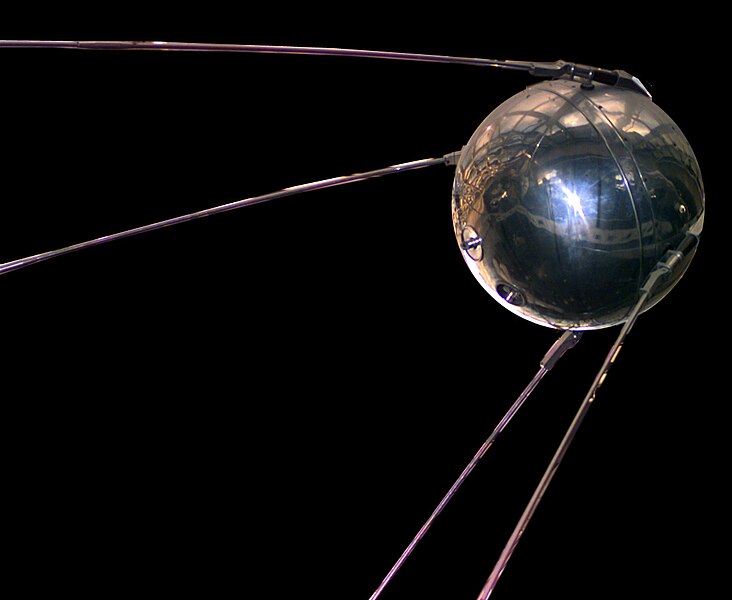Lost in meetings and a rare night of normal sleep was a chance to wish Sputnik a happy 50th birthday. On October 5, 1957, the world woke up to reports of an ominous yet exciting beeping that signaled the official beginning of humanity’s space exploration from the day before. Fifty years ago today, many U.S. government officials were probably praying in churches that Sunday morning after surviving the press blitz and political fallout. NASA was established the following year in response to the Soviet success.
The celebration of the half-century milestone was cause for those surviving members of the Sputnik launch to give some backstory about the project. Boris Chertok, one of the founders of the Soviet space program, provided a hidden history behind how the Soviet Union got the upper hand in the Space Race.

Sputnik 1 (Image from Wikipedia via NSSDC Master Catalog by NASA)
Three years earlier, a resolution was adopted calling for artificial satellites to be launched during the International Geophysical Year (IGY) to map the Earth’s surface. IGY was timed to coincide with the high point of the eleven-year cycle of sunspot activity, beginning July 1957. The Americans, who at the start of IGY were struggling with their Vanguard project, were committed to getting a satellite into orbit by the end of 1958.
Chertok and Korolyov were state secrets back in the day, delaying the revelation that Sputnik wasn’t a planned one-upsmanship of the U.S. but rather an opportunistic byproduct of a more important effort: to develop a rocket capable of striking the United States with a hydrogen bomb. The Soviet scientists had over-estimated the weight of the nuclear payload and therefore had the most powerful rocket in existence sitting around. Korolyov saw the stall in that initiative as an opportunity to beat the Americans to orbit.
While the Soviets did have a full-fledged satellite in development, it wasn’t ready for use. So Korolyov ordered the design and construction of a simple version, called PS-1 (“Prosteishiy Sputnik,” or the Simplest Satellite). Weighing 184 pounds, PS-1 was built in less than three months and included no scientific instruments in its payload, since that would have slowed down production. Sputnik was a simple pressurized sphere with two transmitters and four antennas. The heavily polished aluminum exterior was a feature—it reflected the Sun’s rays, preventing overheating. That is what was hastily sent into space, shocking the world.
October 6 was the original date for the Sputnik launch, pushed up two days because Korolyov was convinced the Americans were ready to launch their own satellite. The fears were unfounded, as it would be another seventeen weeks before the launch of Explorer 1. In the interim, Korolyov put another satellite into orbit (this time with a doomed pooch named Laika) and an international audience witnessed a televised launchpad explosion of a U.S. Vanguard rocket.
Although the impact on the U.S. was immediate, it took Pravda a few days to publish a banner headline about the feat.
“At that moment we couldn’t fully understand what we had done,” Chertok recalled. “We felt ecstatic about it only later, when the entire world ran amok. Only four or five days later did we realize that it was a turning point in the history of civilization.”
From AP story published inPhysOrg
For three months, the Soviets ruled outer space. That was about the time it took for the original Sputnik—which circled Earth more than 1,400 times, orbiting every 98 minutes—to burn up in the atmosphere … and for America to garner its first space success.
The Sputnik project isn’t a great example of user-centered (or, dog-centered) design, but it is a fine exemplar of the value of awareness, opportunism and perception. Korolyov was offered a chance at a Nobel Prize (turned down by Kruschev for fear it would create envy among the Soviet scientists) after his work made headlines, but even in-house he was perceived as working with “toys” and not the real important science of delivering nuclear warheads to enemies of the state. By paying attention not only to the politics but the science of other projects, Korolyov was able to capitalize on some dormant resources and energize his own work.
That the West saw the entire operation as planned had the effect of imbuing his country with superpowers—superior intellect, steely-eyed focus, and evil intent. From Korolyov’s perspective, the intended design was the scientific satellite that wouldn’t reach space for another year. The perceived design, though, was something much more sophisticated and sinister, sparking dual reactions of hopelessness and deeper resolve.
After all, the ultimate design was not a beeping satellite. It was the Space Age.
2 replies on “Happy Birthday, Sputnik Panic”
[…] BlogSchmog » Happy Birthday, Sputnik Panic Sputinik! Never take superiority for granted. (tags: sputnik, history, space) […]
[…] Happy Birthday, Sputnik Panic blogschmog.net yesterday 5 sources detail […]